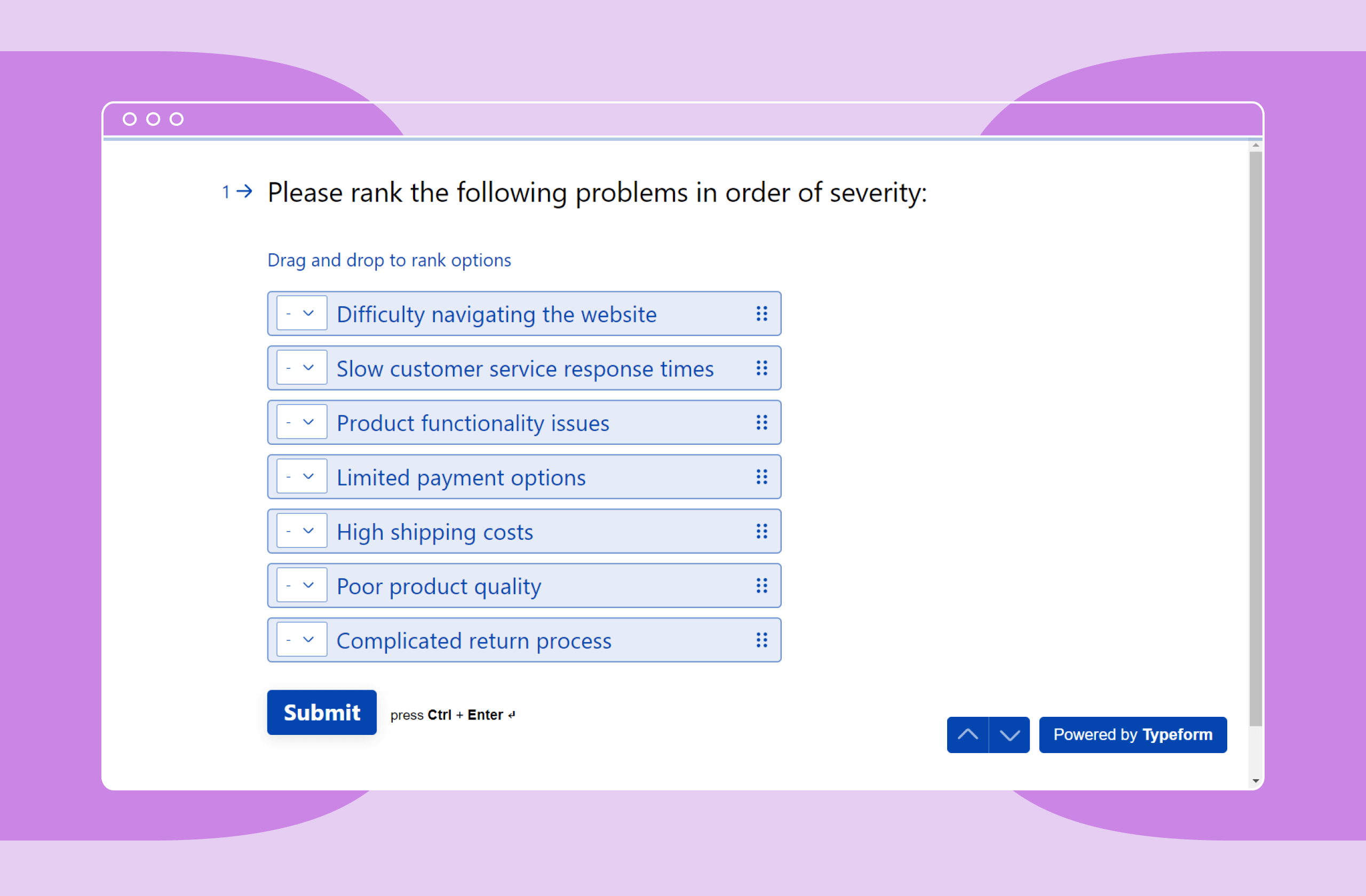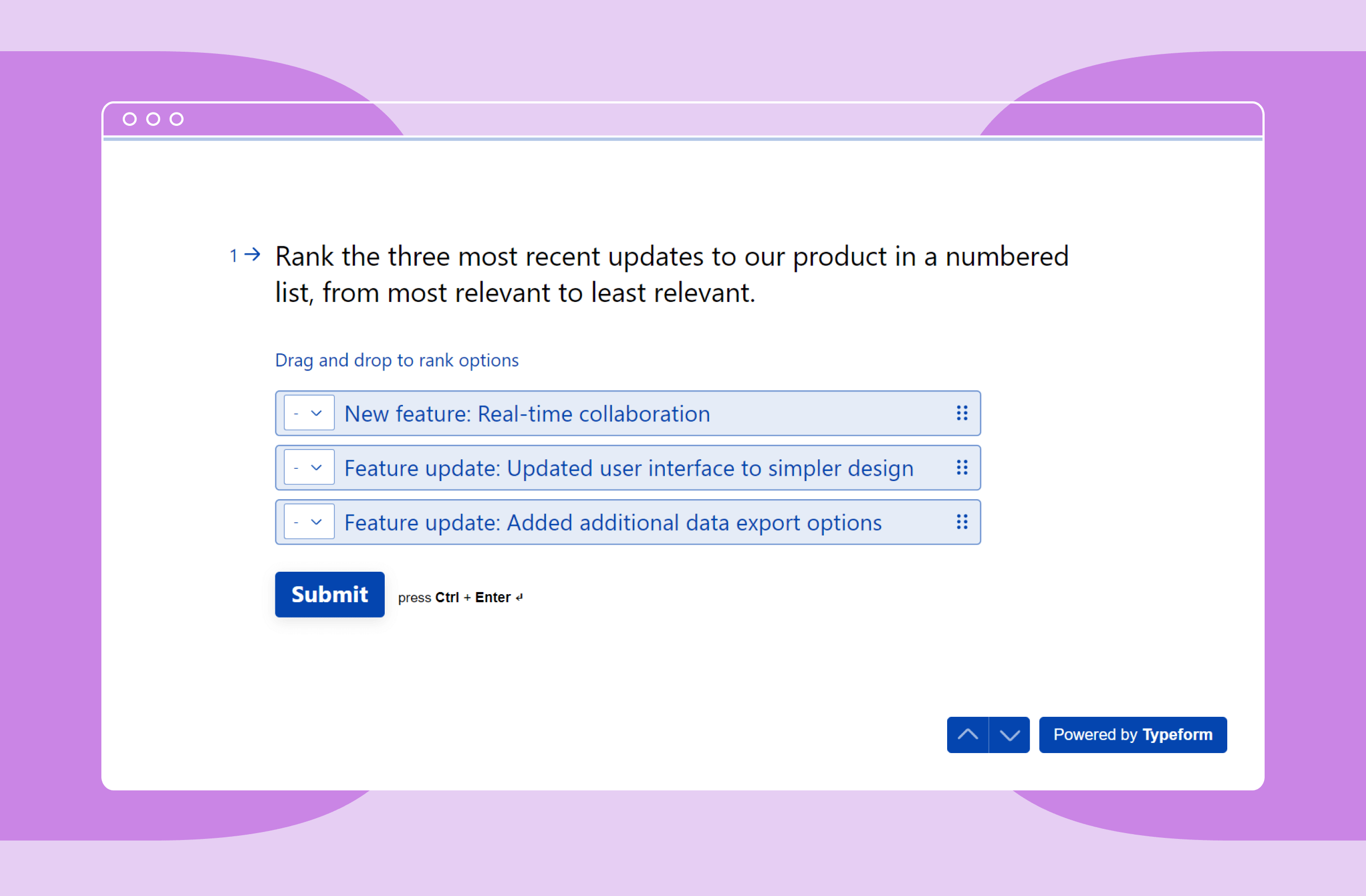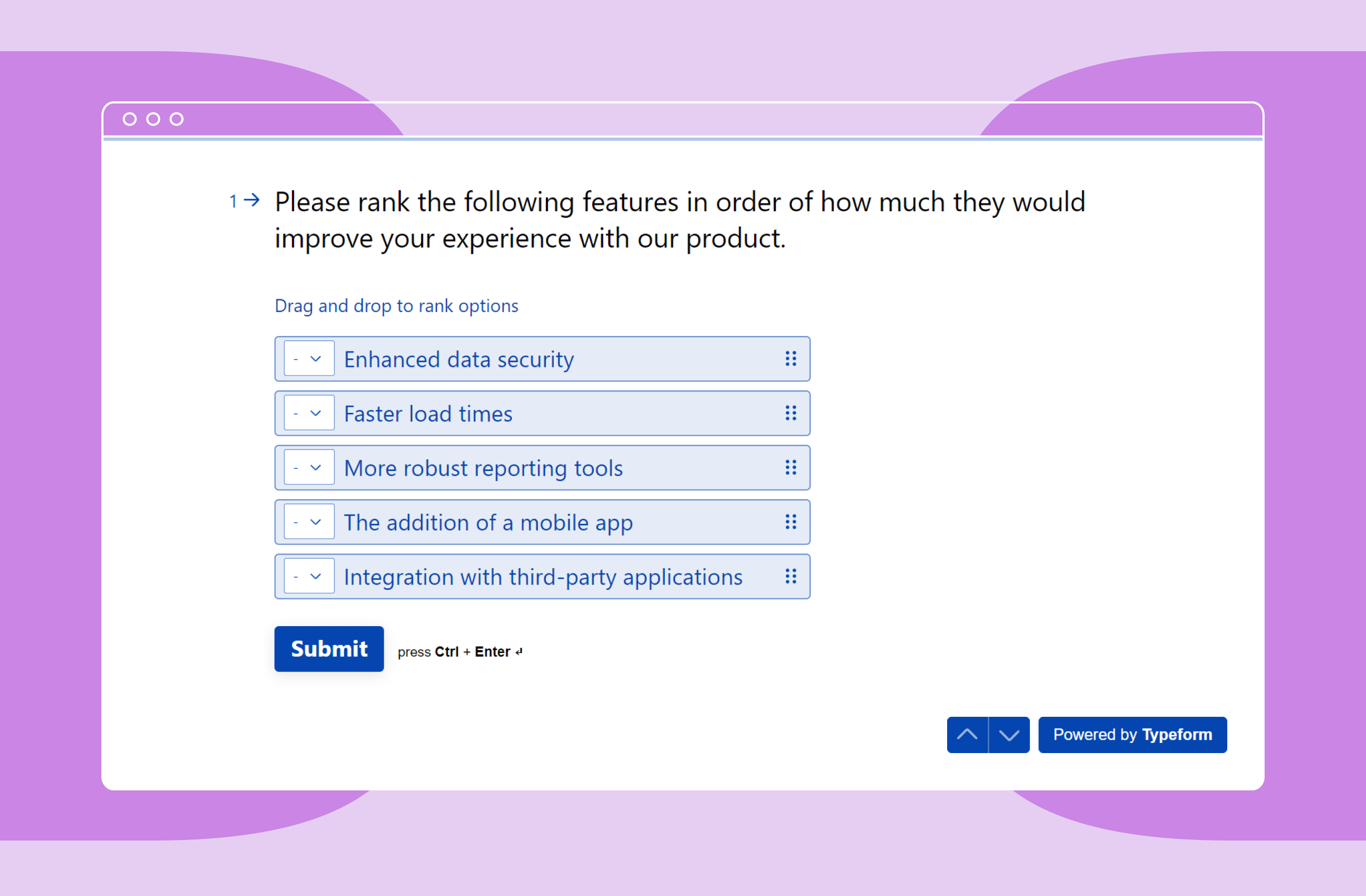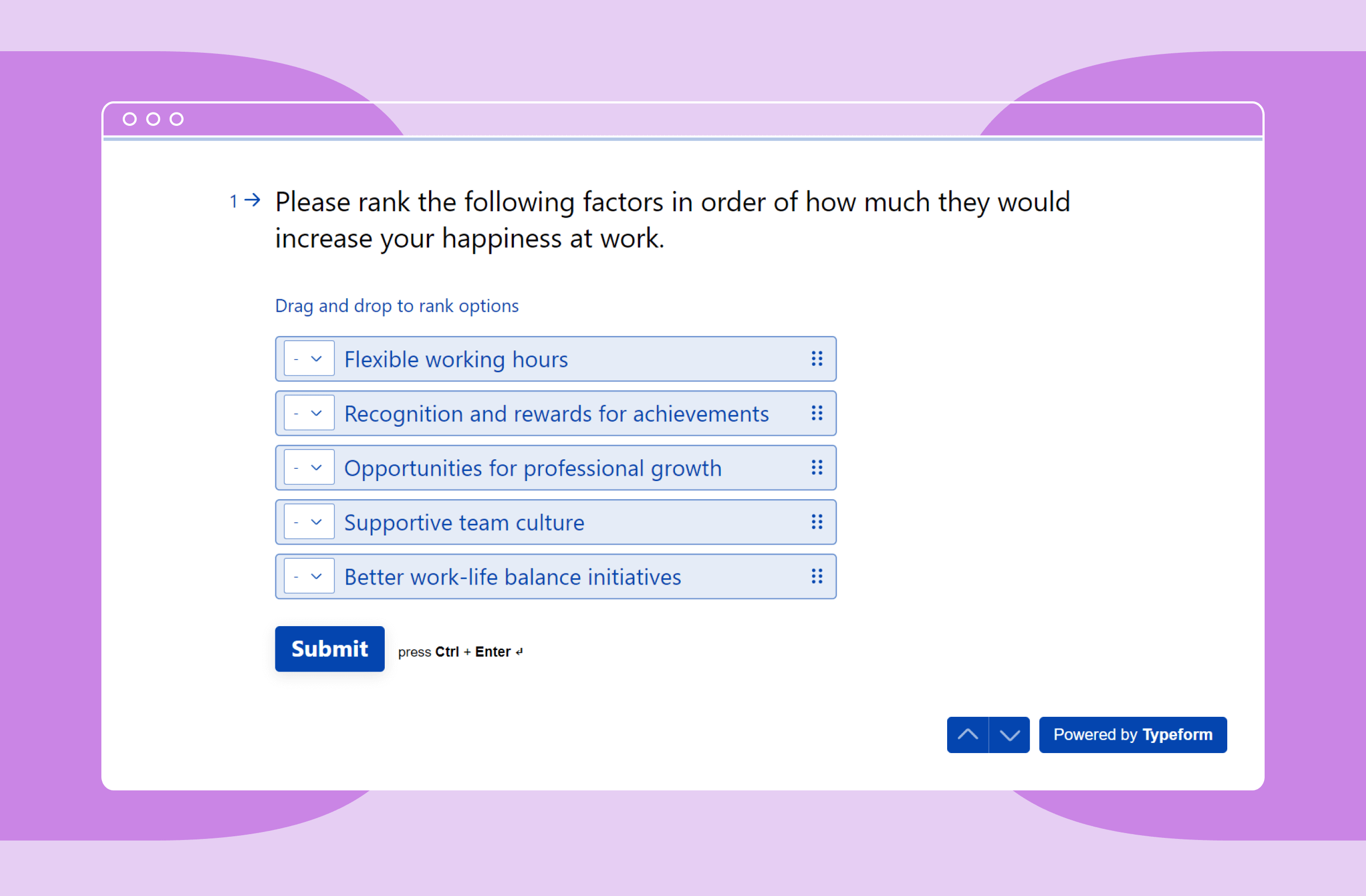Tips
15 ranking survey question examples to use in 2024
Learn how ranking survey questions can help you understand customers and make data-driven decisions with real-world examples.

In the world of surveys, not all questions are created equal. Imagine you’ve been tasked with launching a new product, and you need to collect data about what features or benefits your target audience values most. A simple yes/no question won’t give you the necessary data.
Enter ranking survey questions. These questions—also known as ordinal-polytomous questions if you’re feeling technical—offer form takers the option to order attributes based on their preference. The resulting data offers rich insights that can guide decision-making.
Today, we’ll explore the world of ranking survey questions, including what they are, how to use them, and 15 real-world examples of these questions in practice.
What are ranking survey questions?
A ranking survey question is a specific type of survey question that gives form takers multiple options and asks them to rank those options. Form takers may be asked to rank based on preference, importance, or other ranking factors. Form takers can also rank the options in order of least preference.
Why ask this type of question? Ranking survey questions can help determine customer priorities and preferences, providing critical information for your organization' s decision-makers.
Some common examples of rank order scales used to create ranking survey questions include:
- Drag and drop: Form takers simply drag options into their preferred order of ranking.
- Radio button: Form takers must choose a ranking for each option from a list of provided rankings.
- Text box: Form takers can type their preferred value into a text box from a list of provided values.
- Select box: Form takers click an arrow to move options upward and downward in a list until it matches their ranking preference.
Note: It’s important to distinguish between a ranking question and a rating question. A ranking question allows form takers to rank items in order of preference, often with a drag-and-drop function. A rating question, however, allows form takers to rate a statement on a scale, such as 1 to 5, indicating their level of agreement. In this breakdown, we’ll be discussing ranking questions.
Advantages and disadvantages of using ranking questions
Survey questions come in a wide range of types—including multiple-choice, open-ended, rating, ranking, and Likert scale questions, each designed to gather different forms of data. Ranking questions are a popular choice for certain kinds of data but can be less than optimal for others. The question type you choose depends on the data you need.
Here are some of the advantages and disadvantages of utilizing survey ranking questions:
- Advantages: Ranking questions provide a close look at customer preferences, which is great for analysts looking for fine and precise data. The resulting findings can be beneficial for understanding customer preferences in key decisions.
- Disadvantages: The data provided by ranking questions can be complex and difficult to analyze, requiring a specialist to parse fully. Also, form takers cannot explain why they made the choices they did.
As you can see, ranking survey questions have pros and cons, so choose your question type carefully. If you’ve decided to move forward with ranking questions, check out these 15 examples for inspiration for your next survey.
Ranking survey question examples
Whether you' re conducting market research, assessing employee satisfaction, or collecting any type of preference data, these examples are a great starting point.
Make sure you’re asking the right survey questions by leaning on one of the examples below.
1. Ranking customer problems from high to low
Asking customers to rank their problems with your product, service, or customer experience is an incredibly popular survey question. The data from this question can provide invaluable information on which pain points you need to address in the product and in what order. It’s a great way to get to know your customers better.
Example: “Rank the following problems in order of severity.”
The list would include the following options:
- Difficulty navigating the website
- Slow customer service response times
- Product functionality issues
- Limited payment options
- High shipping costs
- Poor product quality
- Complicated return process
It would look something like this in a live survey:
By analyzing the survey results, you can identify which issue to address first to improve customer satisfaction.
2. Ranking product features used most often
Another common ranking survey question asks customers to rank the product features they use most often. This allows you to get specific information about which features in your product customers may (or may not!) prefer using. This can help you figure out which features to invest resources into improving.
Example: “Rank the following product features in order of how frequently you utilize them, with 1 being the most utilized and 5 being the least utilized.”
This list could include:
- Search function
- Analytics tool
- Customer support chat
- Multiple user profiles
- SMS notifications
By analyzing the results from this survey, you might identify that while your customers strongly dislike the SMS function, they love using your robust analytics features.
3. Ranking important features while ordering a product
This question focuses on the specific features that drive a purchase decision and is great for understanding buyer psychology. When customers order, they make a series of small decisions before clicking the “buy” button—and you want to know what those decisions are. This question helps you find out how customers evaluate you.
Example: “Please rank the following features in order of importance when ordering a product, with 1 being the most important and 5 being the least important.”
This list could include:
- Price
- Delivery speed
- Product reviews
- Return/exchange policy
- Warranty
The results of this survey question will yield information on what factors your customers consider when purchasing.
4. Ranking favorite features of a current product
Asking customers to rank their favorite product features is another way to glean highly specific product information. Your product team will learn about product strengths and weaknesses, and your marketing team will learn what features really resonate with target personas.
Example: “Rank seven of our product features from most favorite to least favorite.”
That list might look like this:
- User-friendly interface
- Fast processing speed
- Customizable settings
- Integrated help center
- Mobile compatibility
- Easy adoption
- Cross-platform collaboration
Form takers can reorder this list according to preference. Collecting this data will give your team direct access to customer preferences within your product, making it easier to focus development efforts on popular parts of the product.
5. Ranking features to improve user experience on a website
A website is critical to any business—especially in software as a service (SaaS). When exploring ways to improve the user experience, you can ask focused questions about specific parts of that experience, like your website. This can help you find the most impactful changes to implement.
Example: “Please rank the following features in order of how much they contribute to a positive experience on our website.”
Options might include:
- Page load time
- Search function
- Navigation elements
- Mobile-first design and compatibility
- Content recommendations
This data can help you improve your website in ways customers will immediately appreciate.
6. Ranking satisfaction with recent product updates
Another great way to gauge customer preferences is to ask form takers to rank their satisfaction with recent product updates. Evaluating users' satisfaction with your improvements can help you monitor which features resonate most.
Example: “Rank the three most recent updates to our product in a numbered list, from most relevant to least relevant.”
This list could include:
- New feature: Real-time collaboration
- Feature update: Updated user interface to simpler design
- Feature update: Added additional data export options
This data will help your team understand which updates have resonated most positively with your users.
7. Ranking reasons that would cause a customer to leave
This ranking survey question attempts to anticipate problems before they occur by asking users what might cause them to leave or become disloyal to your brand.
Example: “Rank these common industry complaints by how likely you are to stop using our service if they occur.”
This list could include:
- Poor customer service
- Increasing costs
- Lack of AI-driven features
- Slow loading times
- Difficult-to-navigate interface
This data will empower your team to resolve the issues that create high-risk customers in advance.
8. Ranking trusted brands or competitors
You can also use ranking questions to measure customer opinions and perspectives on other brands in your industry. Understanding what brands your customers trust can go a long way toward understanding their purchasing preferences.
Example: “Rank the following brands in order of trust and preference on a scale of 1-5, with 1 being the most trusted and 5 being the least trusted.”
The resulting list might look something like this:
- Brand A
- Brand B
- Brand C
- Brand D
- Brand E
This data will help your team understand which brands your customers actually trust—and they may not always be the biggest names in your industry.
9. Ranking preferred repayment structures
If you regularly receive customer payment for goods or services, you might benefit from asking customers for their preference on repayment structures. This can help make your billing processes more customer-friendly.
Example: “Please rank the following repayment structures in order of preference, with 1 being the most preferred and 3 being the least preferred.”
The options might be similar to these:
- Monthly payments
- Bi-weekly payments
- Lump sum payments
This data can help you better meet customer needs and provide support where needed.
10. Ranking customer service expectations
Asking your customers about their expectations of your customer success team is another great way to meet and exceed their needs. You can learn what your customers expect from you—and how to improve in the most valuable areas.
Example: “Please rank the following aspects of customer service in order of importance to you.”
Options might include:
- Quick response times to support tickets
- Friendly and knowledgeable support team
- 24/7 help desk availability
- Multiple contact methods (phone, chat, email)
- Personalized service and follow-up
This data can help guide your customer support team to focus on the improvements that will make the most difference to customers.
11. Ranking expectations for future product developments
This ranking survey question asks form takers to identify what changes they want to see in the future. Rather than considering the product as it stands now, you’re asking where the customer wants to see the product develop next.
Example: “Please rank the following features in order of how much they would improve your experience with our product.”
The list might include:
- Enhanced data security
- Faster load times
- More robust reporting tools
- The addition of a mobile app
- Expanded integration with third-party applications
On a live survey, it might look something like this:
This data can help leadership determine future product developments and where to prioritize allocating time and resources.
12. Ranking the most important employee benefits
You can also use ranking questions to better understand your employee’s needs and preferences. For instance, knowing which benefits your employees value most can help you allocate resources to increase retention and satisfaction.
Example: “Please rank the following employee benefits in order of importance to you, with 1 being the most important and 5 being the least important.”
That list might look something like:
- Health insurance
- Flexible working hours
- Paid time off
- Retirement savings plan
- Professional development opportunities
The results of this survey can help your company prioritize the benefits your employees prefer.
13. Ranking tools that help the most at work
Another great question for employees is which tools they find most useful at work. Identifying the tools with the highest ROI can increase productivity and employee satisfaction and provide important insight into which tools to continue investing in.
Example: " Please rank the following tools according to how much they help you perform your job.”
Options might include:
- Project management software (e.g., Asana, Trello)
- Communication tools (e.g., Slack, Microsoft Teams)
- Data analysis tools (e.g., Excel, Tableau)
- Time-tracking software (e.g., Toggl, Clockify)
- Document collaboration platforms (e.g., Google Workspace, Microsoft 365)
The resulting data can be invaluable when it comes to paring down a tech stack.
14. Ranking preferred managerial styles
Another great way to improve employee engagement and satisfaction is to ask them to rank their preferred managerial styles. You can use the resulting data to coach managers and improve communication and collaboration.
Example: “Please rank the following managerial styles in order of your preference, with 1 being the most preferred and 5 being the least preferred.”
That list might include the following:
- Hands-on coaching and mentorship
- Autonomous and hands-off management
- Collaborative decision-making
- Structured and directive leadership
- Feedback-focused and continuous improvement
This is an excellent question for tailoring managerial practices to employee happiness.
15. Ranking factors that would increase employee happiness
Ask a ranking question to see what employees value most if you' re looking for ways to improve employee happiness and satisfaction. (Why guess if you can just ask?)
Example: " Please rank the following factors in order of how much they would increase your happiness at work.”
That list could include:
- Flexible working hours
- Recognition and rewards for achievements
- Opportunities for professional growth
- Supportive team culture
- Better work-life balance initiatives
In a live survey, that might look like this:
The data collected in this survey can help your team decide which employee satisfaction measures to prioritize to increase retention specifically on your team.
Ranking question best practices
Now that you have no shortage of ideas for implementing ranking questions in your next survey, let’s talk about best practices.
Here are a couple of our recommended do’s and don’ts for ranking questions:
- Do: Group items that are closely related together. Doing so ensures form takers can make meaningful comparisons rather than contrasting apples and oranges.
- Do: Use categories rather than highly specific terms. This simplifies the task for form takers and will help capture broader trends.
- Do: Limit the available choices where possible. This prevents overwhelming the form takers and makes it easier for them to provide accurate rankings.
- Don’t: Build long lists of rankable values, as it can be overwhelming.
- Don’t: Skip the explanation of how to rank the provided items. Clear direction in a survey is necessary for accurate results.
- Don’t: Use ranking questions when you want a concrete answer like “10” or “best” from the survey. Ranking questions are best used to gauge preferences, not provide concrete data points.
Remember: Question format matters. When you are ready to analyze survey data, always consider the question format when evaluating responses.
Start your next survey with Typeform
Ranking survey questions are a powerful tool in any researcher’s toolbox. Whether you want to get to know your employees better, determine the most popular product in your catalog, or delve deeper into any other preference-based dataset, ranking questions are the way to go.
Ready to try out some ranking questions of your own? Try Typeform today—it’s free!





.png)

